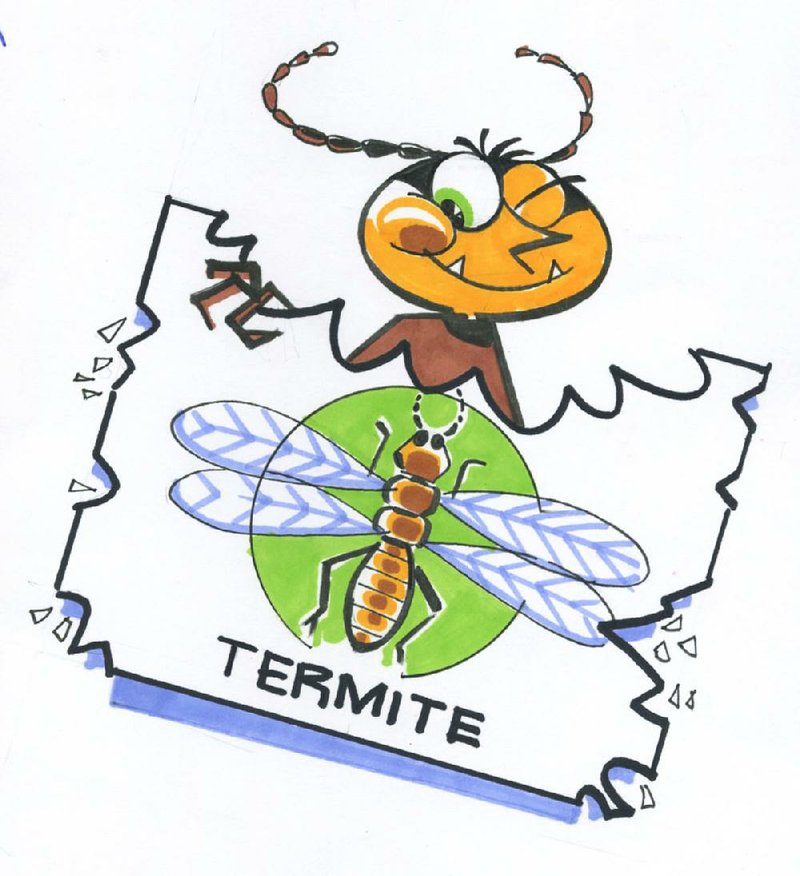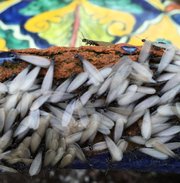Q I was picking up sticks under our river birch and saw these whitish, transparent, flying insects crawling all over the ground and clustered on a pot. We had new bark mulch installed last weekend but don't know if there is any connection. Do you know what type of insect this is and how to get rid of them?
A This is a swarm of termites, the winged adults that fly away to form their own colony. If you see a swarm of termites around your home, then there likely is a well-established colony of termites living in or near your home. Swarming usually occurs during the daytime, and it indicates that termites are nearby. The swarmers likely came from a nearby underground nest. If most of the insects are found outdoors, then the nest is likely somewhere in your yard, possibly near an old tree stump or landscape timbers. If you find most of the swarmers indoors, then you probably have an infestation under or in your home. If you have a termite contract, contact the pest control company so they can take appropriate action. If you do not have a termite contract, contact two or three pest control companies and arrange for them to inspect the property. If your home or business is infested with termites, consider getting it treated.
Q I have eight gardenia bushes in different parts of my yard. My guess is that they were planted sometime in the early '60s but have no proof. This year, one of the bushes has yellow leaves interspersed with the green ones. It is budding like the rest, but this is the only one showing the yellow leaves.
A Gardenias are evergreen shrubs, but they do shed old leaves. Typically this is done in late fall to early winter, but we are seeing some of it this spring. As long as the yellow leaves are down on the stem and near the tip of the branch, no worries.
Q When is it time to separate and replant iris bulbs?
A The best time to separate them is six to eight weeks after bloom, typically in late July. You need to get this done early enough to allow the rhizomes to get re-established before fall.
Q I have read your recent articles where you advise those of us with tropical hibiscus plants to prune off some of the top half of the shrub. What I am asking is if that same advice goes for a hibiscus tree?
A The tree forms still need to be pruned, but you would not prune beneath where the "ball" appears. Leave the trunk intact, to keep the plant tree-formed, but shear the top part to encourage new growth. I would also repot. If you cut them back severely, you would end up with a bush and not a tree-formed topiary.
Q I planted a Chinese pistache last fall. This year it budded and had nice leaves on it and now the leaves have dried out and it looks awful. It has all happened in the last week, and I was wondering if you would know what is wrong and if I can fix it. [The reader sent in a photo.]
A It doesn't look good. We did see a bit of winter damage on established Chinese pistache trees, but that would have prevented the leaves from emerging. I am wondering if it could have been attacked by the Asian ambrosia beetle. We have been having reports of trees that die seemingly overnight that were attacked by this insect. Asian ambrosia beetles tend to attack young ornamental trees, primarily Japanese maple, dogwoods, ornamental cherry and styrax. We have never had a report on Chinese pistache, but the age and size of your tree could make it a candidate. Once the invader is inside a tree, there is no control other than destroying the tree. I would wait a few weeks and see if any new leaves appear, and if not, replace it.
DEAR READERS: One of our readers showed a recent article about invasive species to her daughter-in-law, who is from China. When asked how the Chinese control kudzu (we imported kudzu from China), her reply was simply, "We eat."
So all you cooks out there, let's get creative and find some good kudzu recipes to start controlling this invasive species.
Janet B. Carson is a horticulture specialist for the University of Arkansas Cooperative Extension Service. Write to her at 2301 S. University Ave., Little Rock, Ark. 72204 or email her at
jcarson@arkansasonline.com
HomeStyle on 05/23/2015

